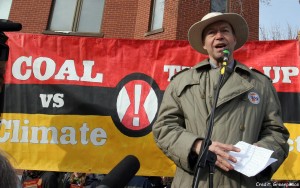His celebrity precedes h im, but Jim Hansen is making a splash, again.
im, but Jim Hansen is making a splash, again.
Hansen’s been on a self-imposed hiatus from the celebrity spotlight. He had to be, he said; his notoriety had become too distracting, so he withdrew from the spotlight in order to do science.
This is the man, after all, who has been arrested twice for his advocacy to end the use of fossil fuels, which he believes is at the heart of human-caused global climate warming.
Hansen first attracted controversy in 1988 when, as head of NASA’s Goddard Institute for Space Studies, he testified before Congress and presented his evidence that global warming is caused by human activity.
Hansen, who now directs a climate science program at Columbia University, is still stirring up controversy and says his latest paper, Ice Melt, Sea Level Rise and Superstorms (that is a shortened title), may be his most important.
The paper was posted July 23 on Atmospheric Chemistry and Physics, an open-access “discussion” journal published by the European Geosciences Union. Peer review in ACP occurs online and in public.
In the paper, Hansen and his 16 co-authors present their claim that paleoclimate observations from core samples demonstrate an amplifying feedback process that contributes to nonlinear ice sheet disintegration (see diagram from the paper, below).
Translation: Polar ice is melting faster than previously thought as melting polar ice cools polar seas and disrupts ocean currents. The change in ocean currents leads to cooler polar seas, which traps warm water below the surface where it further erodes polar ice.
Hansen et al. argue that we are already perilously close to 2° Celsius limit on global warming and warn that ocean levels could rise much higher and more quickly than previously envisioned. At the extreme, sea levels could rise by as much as 30 feet within this century, leading to the functional loss of all coastal cities at a social and economic cost that is “practically incalculable.”
Hansen says the 2° C limit on global warming set in the Copenhagen Accord is not a safe “guardrail.” He also is critical of other solutions, such as the Obama Administration’s proposed Clean Power Plan to reduce carbon dioxide emissions, which he calls a “band-aid.” And he also calls the Intergovernmental Panel on Climate Change’s cap-and-trade approach “half assed.”
Hansen’s solution is “to make the prices of fuels honest” and then let the markets decide. His plan would impose a tax on CO2 across the globe. There would be political resistance, but he says it would only take a couple of big countries to get the ball rolling. If those countries imposed their own tax, as well as a tariff on goods coming from countries that don’t have a CO2 tax, countries faced with paying the tariff would quickly conclude that they would prefer to collect the tax on their side of the border.
Hansen seems to have developed a knack for attracting controversy from all sides. His paper is already attracting attention and controversy. His CO2 tax idea is likely to be dismissed by conservatives that as another misguided government intervention, but he says the funds from his carbon tax would not go toward more government programs, but should be funneled back to the people.
And unlike some environmental advocates, Hansen does not believe that wind and solar power alone are not sufficient to solve the problem of global warming. “There will have to be a place for nuclear power.”
But maybe the man who once advocated jail sentences for the heads of big energy companies for crimes against humanity is mellowing. He now says that industry is not the problem. “Look, these are smart people and they know how to get things done.” Even among some on the more conservative end of the spectrum, there is a recognition that “this could come back to bite us in the butt.”
But Hansen still believes that CO2 emissions have to be reduced by 6% a year. If we are still using fossil fuels, that number rises to 15% a year. His main point, though, is that time is running out. “We don’t have time to wait, if we don’t want to see irreversible damage from species extinction and ice sheet disintegration.”
But Hansen is also practical. He sees his time ending. He says his generation has not managed to changing the trajectory of global warming. That is “going to be up to the young people,” he says, but he is not recommending that they go out and get arrested. “That’s for the geezers” like him. Young people, he says, should do science.




